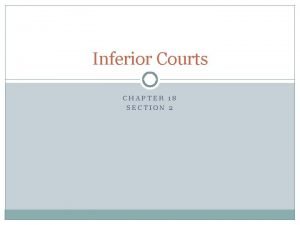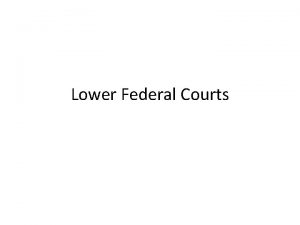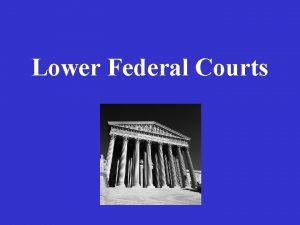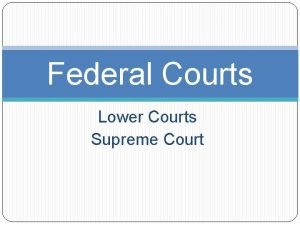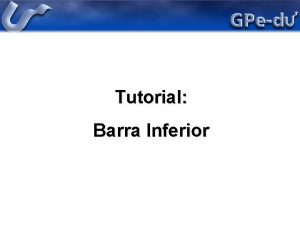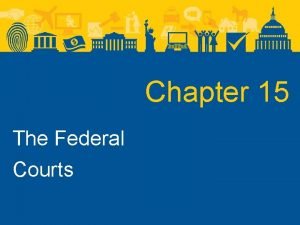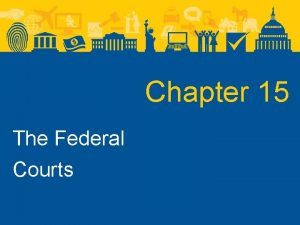The Inferior Courts Its Complex Lower Federal Courts















- Slides: 15

The Inferior Courts It’s Complex

Lower Federal Courts � The Framers created the national judiciary in Article III of the Constitution. � The Constitution created the Supreme Court and left Congress to establish the inferior courts—the lower federal courts. There are two types of federal courts: (1) constitutional courts and (2) “special” or legislative courts.

Types of Federal Courts

The District Courts Federal Judicial Districts � � Created by Judiciary Act of 1789 to serve as federal trial courts. The 94 federal judicial districts include at least one district in each State, the District of Columbia, and Puerto Rico. Larger and more populous States are divided into two or more districts, reflecting the larger amount of judicial work done there. District courts hear thousands of cases each year. District Court Jurisdiction � � � Have original jurisdiction over most cases that are heard in federal courts. Hear a wide range of criminal cases and civil cases. A criminal case, in the federal courts, is one in which a defendant is tried for committing some action that Congress declared by law to be a federal crime. A federal civil case is one which involves noncriminal matters.

The District Courts � District courts use two types of juries for criminal cases: • Grand jury: 16 – 23 people who hear charges against a suspect; if enough evidence exists to hold a trial, issues an indictment – formal accusation charging a person with a crime • Petit jury: 6 -12 people, aka “trial jury; ” hear evidence in criminal or civil cases, reach a verdict of guilty or not guilty in criminal cases or decide “finding” for either plaintiff or defendant in civil cases

Court Officers Federal judges have many levels of support in order to fulfill their roles: • The President nominates, and the Senate approves, a United States attorney for each federal judicial district to represent the U. S. in all civil and criminal cases. • United States magistrates are appointed by each federal district court judge to handle duties ranging from issuing warrants to setting bail in federal criminal cases. • Each federal district judge appoints one bankruptcy judge for their district. • A United States marshal serves each of the district courts. Marshals act much like county sheriffs in regard to federal crimes.

The Courts of Appeals � The courts of appeals were created in 1891 to handle much of the burden that the Supreme Court faced in ruling on appealed cases. Appellate Court Judges � Altogether, 179 circuit judges sit in the 12 appeals courts. � A Supreme Court justice is also assigned to each of the circuits. Appellate Court Jurisdiction � The courts of appeals only have appellate jurisdiction, hearing cases on appeal from lower federal courts.

Other Constitutional Courts The Court of Appeals for the Federal Circuit � This appellate court has nationwide jurisdiction and hears cases from several different courts. � Most cases heard arise from the U. S. Court of International Trade, the U. S. Court of Federal Claims, and the U. S. Court of Appeals for Veterans Claims. The Court of International Trade � The Court of International Trade hears civil cases arising out of tariff and other traderelated laws.

Legislative Courts � Congress has created a number of courts to help it exercise its powers. � Ex. power of Congress to tax led to the creation of the U. S. Tax Court

Legislative Courts The Court of Federal Claims � The U. S. Court of Federal Claims handles all pleas against acts of the United States government. � Those who have claims against the United States can possibly secure redress—satisfaction of a claim, usually through payment—through this court. The Territorial Courts � Under its power to govern the territories of the United States, Congress created courts for the nation’s territories. � These courts are in places such as Guam and the Virgin Islands, and function much like the local courts in the 50 States.

Legislative Courts The District of Columbia Courts � As directed in the Constitution, Congress established a system of courts for the “Seat of Government of the United States. ” � The District of Columbia handles all local judicial matters for the district, including trials and appeals. The United States Tax Court � The U. S. Tax Court was created by Congress in 1969. � The Tax Court hears civil but not criminal cases involving disputes over the application of the tax laws. � Its decisions may be appealed to the federal courts of appeals.

Legislative Courts The Court of Appeals for the Armed Forces � This court is a civilian tribunal, a court operating as part of the judicial branch, entirely separate from the military establishment. � The court reviews the more serious convictions of members of the armed forces at a court-martial, or trial involving military law. The Court of Appeals for Veterans Claims � The Court of Appeals for Veterans Claims hears cases in which individuals claim that the Department of Veterans Affairs has denied or otherwise mishandled valid claims for veterans’ benefits.

Selection of Federal Judges � The power to appoint judges to federal courts falls on the President. � The President nominates Supreme Court justices, as well as federal court judges, who are then subject to the approval of the Senate. � Most federal judges are drawn from the ranks of leading attorneys, legal scholars and law school professors, former members of Congress, and State courts.

Selection of Federal Judges � Presidents consider several factors when appointing federal judges, including: • Party affiliation • Judicial philosophy • Senatorial courtesy (the practice of submitting the name of a candidate for a district court to the senator(s) of the candidate’s state before submitting it formal Senate approval; not used for SCt or courts or appeals) • Personal and legal background

Selection of Federal Judges � Judges appointed to the constitutional courts, including the Supreme Court, are appointed for life. � Judges of constitutional courts may only be removed by their own will or through impeachment. Only 13 federal judges have ever been impeached, and of those just seven were convicted. � Judges who sit in the special courts are appointed for terms varying from 4 to 15 years. � Congress determines salaries for federal judges.
 Chapter 18 section 2 the inferior courts worksheet answers
Chapter 18 section 2 the inferior courts worksheet answers Oedipus complex and electra complex
Oedipus complex and electra complex Simple compound complex and compound-complex sentences quiz
Simple compound complex and compound-complex sentences quiz Contemporary psychodynamic theories
Contemporary psychodynamic theories Ghon complex
Ghon complex Sublimation in psychology
Sublimation in psychology Simple, compound-complex rules
Simple, compound-complex rules The emigree by carol rumens
The emigree by carol rumens Its halloween its halloween the moon is full and bright
Its halloween its halloween the moon is full and bright When a train increases its velocity, its momentum
When a train increases its velocity, its momentum Its not easy but its worth it
Its not easy but its worth it Cloudy windy rainy sunny
Cloudy windy rainy sunny If its square its a sonnet
If its square its a sonnet Lời thề hippocrates
Lời thề hippocrates Thế nào là giọng cùng tên? *
Thế nào là giọng cùng tên? *
